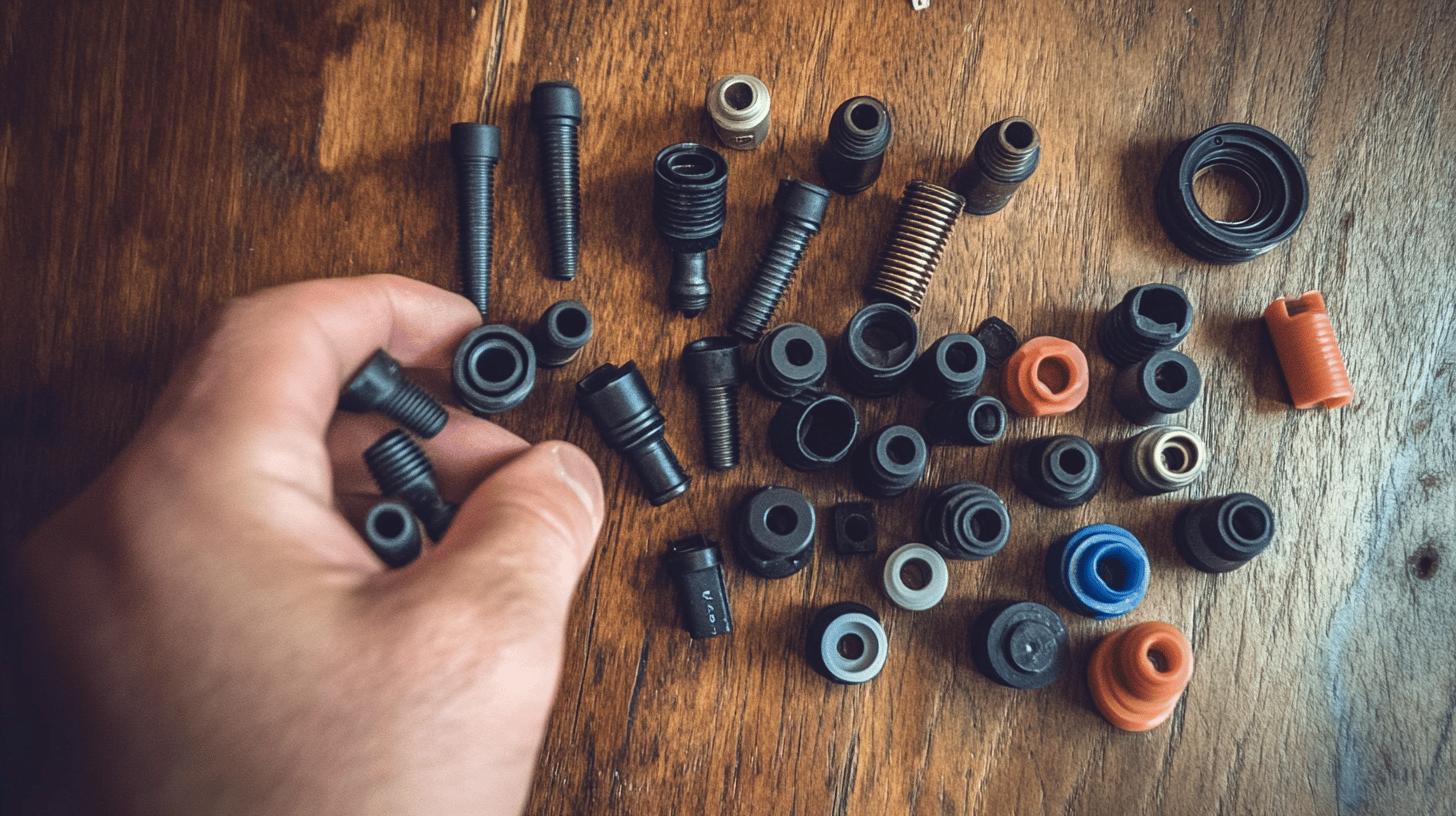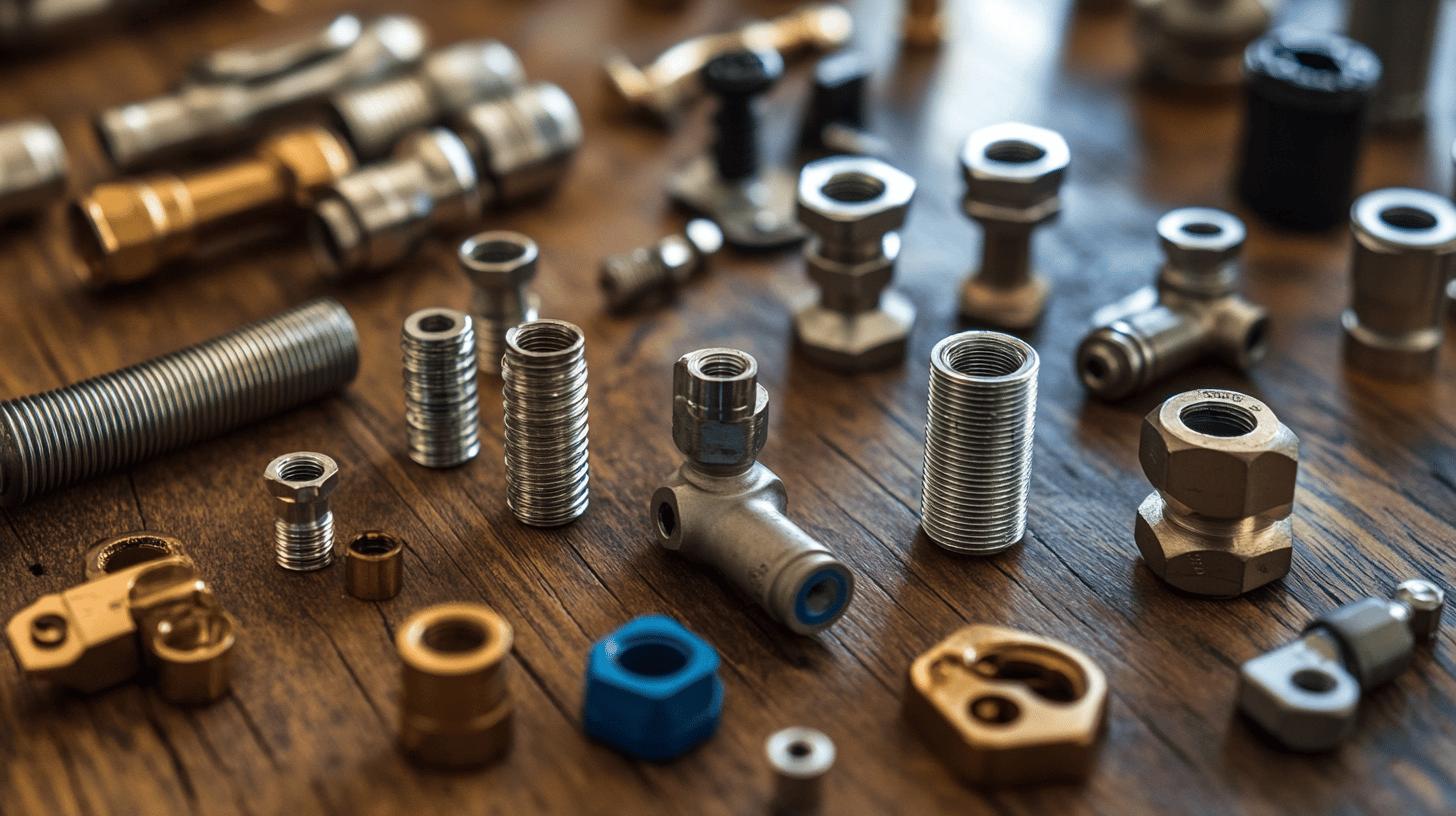TL;DR:
- Plumbing fittings connect, terminate, control flow, and change pipe directions.
- Key types:
- Elbows (90°/45° angles),
- Tees (T-shaped, splits flow),
- Couplings (connect pipes),
- Unions (easy disconnection),
- Adapters (different pipe types/sizes).
- Materials:
- PVC (residential),
- Copper (corrosion-resistant),
- Brass (hot/cold water),
- Stainless steel (high-pressure),
- Threaded (gas lines).
- PEX fittings include crimp, push-to-connect, and expansion types.
- Choosing fittings:
- Ensure material compatibility, precise sizing, adhere to standards (NPT/BSP), and consider flow direction and specific needs.
Ever wonder why your plumbing looks like a maze of pipes and joints? The answer is plumbing fittings. These important parts connect, control flow, and change the direction of pipes, keeping everything working smoothly. Knowing about different types of fittings can save you time, money, and hassle. In this article, we’ll go over five essential plumbing fittings you should know. Let’s dive in and simplify the basics of your home’s plumbing system.
Overview of Types of Plumbing Fittings
Plumbing fittings are key parts of any plumbing system. They connect, stop, control flow, and change the direction of pipes, making sure water supply and drainage systems run smoothly in homes and businesses. Choosing the right fitting is important for keeping the system working properly.
Picking the right fittings can prevent leaks, improve water flow, and extend the life of your plumbing. Using the wrong ones can lead to expensive repairs and water damage. That’s why it’s important to know about the different types of fittings and what they’re used for.
- Elbows: Change the direction of flow, typically available in 90-degree and 45-degree angles.
- Tees: T-shaped fittings that split the flow into two directions.
- Couplings: Connect two pipes and are often used for repairs.
- Unions: Allow easy disconnection and reconnection of pipes.
- Adapters: Connect pipes of different types or sizes.
Plumbing fittings are made from different materials, each for specific uses. PVC fittings are strong and easy to install, making them a favorite in home plumbing. Copper fittings resist rust and are often used for water supply lines. Brass fittings are versatile and work well for both hot and cold water. Stainless steel fittings are used in high-pressure systems because of their strength and durability. Choosing the right material for your fittings is key to making sure they last and work properly.
Detailed Descriptions of Common Plumbing Fittings

Knowing about different plumbing fittings is important for anyone tackling a plumbing project. Each type of fitting has a specific job, helping to keep the system efficient and reliable. Here’s a closer look at some of the most common fittings you’ll come across.
Elbows
Elbows are important for changing the direction of water flow in a plumbing system. They come in 90-degree and 45-degree angles, giving flexibility in how pipes are routed. Elbows can be made from materials like PVC, copper, and stainless steel, depending on the job.
Tees
Tees are T-shaped fittings that split the flow into two directions. They’re used to branch off a main pipe into two separate lines. You’ll find tees in both home and commercial plumbing systems, made from materials like PVC, brass, and copper.
Couplings
Couplings are used to connect two pipes, often for repairing broken or damaged sections. They come in different types, like slip and compression couplings, and are available in materials such as PVC, copper, and stainless steel.
Unions
Unions make it easy to disconnect and reconnect pipes, which helps with maintenance and repairs. Unlike couplings, you can unscrew unions without cutting the pipe, making them great for systems that need regular upkeep. Unions come in materials like brass, stainless steel, and copper.
Adapters
Adapters are used to connect pipes of different types or sizes, making them essential for transitions like connecting a copper pipe to a PVC pipe. They come in male and female types and are made from materials like brass, copper, and PVC.
Valves
Valves control the flow of water or gas in a plumbing system. There are several types of valves, like ball valves, gate valves, and check valves, each with its own purpose. Ball valves are often used to shut off flow, while gate valves help regulate it. Check valves make sure that fluid flows in only one direction. Valves are usually made from brass, stainless steel, or plastic.
| Fitting Type | Use | Material |
|————–|———————————–|———————————–|
| Elbows | Change direction of flow | PVC, Copper, Stainless Steel |
| Tees | Split flow into two directions | PVC, Brass, Copper |
| Couplings | Connect two pipes, often for repairs | PVC, Copper, Stainless Steel |
| Unions | Easy disconnection and reconnection | Brass, Stainless Steel, Copper |
| Adapters | Connect different types or sizes of pipes | Brass, Copper, PVC |
| Valves | Control flow within the system | Brass, Stainless Steel, Plastic |
Specialized Plumbing Fittings
Specialized plumbing fittings are important for specific situations where regular fittings won’t work. These fittings are designed for unique needs, like handling high pressure, resisting corrosion, or connecting different types of pipes. Knowing when to use these specialized fittings can really improve the efficiency and lifespan of your plumbing system.
- PVC Fittings: Durable and easy to install, commonly used in residential plumbing.
- Copper Fittings: Resist corrosion and are often used in water supply lines.
- Brass Fittings: Suitable for both hot and cold water applications.
- Threaded Fittings: Used for connecting pipes with threads, common in gas lines and high-pressure systems.
PVC fittings are popular in home plumbing because they’re durable, lightweight, and resistant to chemicals, making them ideal for water supply and drainage. Copper fittings resist corrosion and handle high temperatures, making them great for water supply lines and hot water applications.
Brass fittings are versatile for both hot and cold water, while stainless steel fittings are perfect for high-pressure situations due to their strength and durability. Threaded fittings are essential for connecting pipes in gas lines and high-pressure systems, ensuring a secure, leak-proof connection. Understanding these specialized fittings helps you make better choices for your plumbing projects.
PEX Plumbing Fittings

The rise of PEX plumbing has changed the game for modern plumbing systems. PEX (cross-linked polyethylene) pipes are flexible, durable, and easy to install, making them great for things like water supply lines and radiant floor heating. PEX fittings are super important because they connect these flexible pipes and help make sure everything is secure and leak-free.
- Crimp Fittings: Use copper or stainless steel rings to secure the pipe, providing a reliable and strong connection.
- Push-to-Connect (SharkBite) Fittings: Convenient and easy to use but should be accessible for future maintenance.
- Expansion Fittings: Require a special tool to expand the pipe before connecting, ensuring a tight and secure fit.
The installation methods for PEX fittings vary based on the type. Crimp fittings require sliding a crimp ring over the pipe and using a crimping tool to secure it, which is known for being strong and reliable. Push-to-connect fittings, like SharkBite, are super convenient because you just push them onto the pipe and they lock in place. They’re perfect for quick repairs, but make sure to put them where you can easily access them later. Expansion fittings need an expansion tool to widen the pipe before inserting the fitting, ensuring a tight connection.
PEX fittings come with a ton of benefits. They’re flexible, which makes it easier to work around obstacles and cuts down on the number of fittings needed. Plus, PEX is resistant to corrosion and scale buildup, which helps your plumbing last longer. The installation is also usually quicker and easier than with traditional copper or PVC systems, making PEX a great choice for new projects or upgrades.
How to Choose the Right Plumbing Fittings
Picking the right plumbing fittings is super important for making sure your plumbing system works well and lasts a long time. You need to think about the type of pipe, the flow direction, and the specific needs of your system. Using the wrong fittings can cause leaks, inefficiencies, and expensive repairs.
Material compatibility is also key. You need to make sure the fittings match the pipe materials to keep everything working properly. Getting the right size and sticking to fitting standards is crucial, too—just a tiny mistake can lead to big problems.
- Material Compatibility: Ensure the fitting material matches the pipe material to prevent corrosion or wear.
- Precise Sizing: Accurate measurements are vital to avoid leaks and ensure a tight fit.
- Fitting Standards: Adhere to standard specifications like NPT (US) or BSP (British) for consistency.
- Flow Direction: Consider the direction of the flow and choose fittings that facilitate it.
- Specific Needs: Assess the specific requirements of your plumbing system, such as pressure and temperature.
Material compatibility is really important for making your plumbing system last and work efficiently. For example, using brass fittings with copper pipes helps prevent corrosion, while PVC fittings are best for plastic pipes. Choosing the right materials ensures everything fits together well, reducing the chance of leaks and damage.
Fitting standards are also crucial for keeping things consistent and reliable. Common standards include NPT (National Pipe Thread) in the US and BSP (British Standard Pipe) in the UK. Sticking to these standards makes sure your fittings match the pipes correctly, which helps avoid misalignment or leaks. Transition fittings are great for connecting pipes made of different materials, ensuring a secure and leak-proof connection.
Final Words
Knowing about the different types of plumbing fittings is super important for any plumbing project. Fittings like elbows, tees, couplings, unions, adapters, and valves help connect, direct, and control the flow of pipes. Understanding the materials, whether it’s PVC, copper, or stainless steel, ensures you choose the right fit for your needs.
In conclusion, picking the right fittings can boost efficiency, minimize leaks, and make your plumbing system last longer. By learning about plumbing fittings, you’ll feel more confident tackling any plumbing challenge that comes your way!
FAQ
What are the different types of pipe fittings?
Pipe fittings include elbows, tees, couplings, unions, adapters, and valves. They connect, terminate, control flow, and change the pipe’s direction. Each type serves specific functions in plumbing systems.
What type of fittings do plumbers use?
Plumbers commonly use PVC, copper, brass, and stainless steel fittings. Each material is chosen based on its specific advantages and suitability for different plumbing applications.
What are three common pipe fittings?
Common pipe fittings include elbows, tees, and couplings. Elbows change the pipe direction, tees split flow into two directions, and couplings connect two pipes usually for repairs.
What are the different types of plumbing joints?
Plumbing joints include solder joints, compression fittings, push-fit fittings, threaded fittings, and flanges. Each type provides reliable connections for various plumbing applications and materials.
Plumbing fittings names and pictures?
Elbows, tees, couplings, unions, and adapters are common plumbing fittings. Images often accompany their descriptions to illustrate their shapes and uses, making identification easier.
Plumbing fittings names PDF?
For detailed information on plumbing fittings names, including pictures and descriptions, find a dedicated PDF guide by searching for “plumbing fittings names PDF” online.

